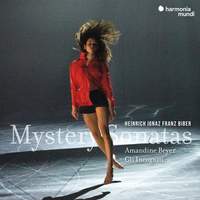Recording of the Week,
Biber's Rosary Sonatas from Amandine Beyer and Gli Incogniti
If there is one work for which Heinrich Ignaz Franz Biber is known, it is surely his set of fifteen Rosary Sonatas for violin and continuo. Forgotten for almost two centuries, they were not published until 1905, at which point their virtuosity and extensive use of scordatura (the retuning of one or more strings of the instrument) made them an instant and lasting hit among violinists. Today’s Recording of the Week, a new album from Amandine Beyer and Gli Incogniti, shows once again the sonatas’ power, with Beyer finding a huge range of emotions and sonorities in the subject matter.
 For those readers who aren’t au fait with Catholic devotional practices, the Rosary Mysteries that the sonatas are based on are fifteen significant events in the Biblical life of Jesus. The first five are designated “joyful”, focused on his childhood, the middle five “sorrowful”, culminating in the Crucifixion, and the final five (beginning with the Resurrection) “glorious”. In response, Biber specifies a different scordatura tuning for each sonata, putting the resulting subtle but perceptible changes in the strings’ sonority to the service of the religious images. The Sorrowful Mysteries use tunings that mute the instrument’s sound and create dissonant overtones (as well as giving rise to the symbolic crossing-over of the middle strings for the Crucifixion), while the Joyful and Glorious Mysteries are brighter and more resonant.
For those readers who aren’t au fait with Catholic devotional practices, the Rosary Mysteries that the sonatas are based on are fifteen significant events in the Biblical life of Jesus. The first five are designated “joyful”, focused on his childhood, the middle five “sorrowful”, culminating in the Crucifixion, and the final five (beginning with the Resurrection) “glorious”. In response, Biber specifies a different scordatura tuning for each sonata, putting the resulting subtle but perceptible changes in the strings’ sonority to the service of the religious images. The Sorrowful Mysteries use tunings that mute the instrument’s sound and create dissonant overtones (as well as giving rise to the symbolic crossing-over of the middle strings for the Crucifixion), while the Joyful and Glorious Mysteries are brighter and more resonant.
One thing that stands out about Amandine Beyer’s approach is how closely she adheres to the music’s dance-suite ancestry – the recording itself having arisen out of a staged collaboration with a dance company, evidently inspiring her to continue blending instrumental virtuosity with that sense of the theatrical. As is often remarked about JS Bach, so too here for Biber - there is no contradiction in using dance-forms to illuminate scenes from Scripture. The fourth sonata is particularly in touch with its roots as a danceable, almost swaggering, ciacona. Even in some contexts where it might seem inappropriate, such as the sixth sonata corresponding to the despair of the Garden of Gethsemane, there’s a distinct sense of stately motion.
This isn’t as contradictory as it might seem. While clearly a vivid musical response to the Rosary Mysteries, the pictorialism here is mostly indirect, concerned with impressions rather than specifics. Don’t expect to hear in the music the exact moment that the angel Gabriel appears to Mary, or Hollywood special effects for the Ascension. These are more meditations than strict depictions, and indeed often seem rather like free fantasias. The opening praeludium movements of the first and tenth sonatas are especially so, and are among my favourite tracks on the album; Beyer, too, clearly enjoys the stage-strutting liberty they allow.
Equally, she can certainly be forgiven for digging into the strings for the seventh sonata (the Scourging of Jesus prior to the Crucifixion); the visceral mood of the scene demands nothing less, and the sound she draws from the instrument, with the aid of the increasingly abnormal tensions applied to the strings, is suitably violent. Similarly, in the twelfth sonata’s “aria tubicinum” (where the violinist acclaims the Ascension by imitating an ensemble of trumpets), someone – I suspect lutenist Francesco Romano – adds some lively percussion on the body of their instrument.
A lesser, more naïve composer might have responded to the superficial “happy, sad, happy” contour of the three sets of Mysteries by straightforwardly using major keys for the Joyful and Glorious sonatas, and minor for the Sorrowful. Not so Biber, who for example sets the Crowning with Thorns in B flat major and the Nativity in B minor. One could speculate (as many have) about the theology underpinning all this; but these sonatas inverting the simplistic emotional binary of major/minor are certainly among the most musically thought-provoking, and show Beyer at her most responsive.
Whether intended for “concert” performance, devotional meditation or something in-between, the Rosary Sonatas are a varied and powerful journey through a story that remains emotionally resonant even for many who wouldn’t consider themselves religious. Amandine Beyer and her companions bring a deep sincerity and thoughtfulness to music that could all too easily become lurid and superficial, yet they never lose sight of the mobility at its heart.
Amandine Beyer, Gli Incogniti
Available Formats: 2 CDs, MP3, FLAC, Hi-Res FLAC



